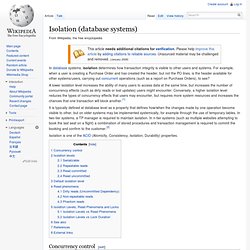

Aide Oracle. Coding Triggers. Triggers are procedures that are stored in the database and are implicitly run, or fired, when something happens.

Traditionally, triggers supported the execution of a PL/SQL block when an INSERT, UPDATE, or DELETE occurred on a table or view. Triggers support system and other data events on DATABASE and SCHEMA. Oracle Database also supports the execution of PL/SQL or Java procedures. This chapter discusses DML triggers, INSTEAD OF triggers, and system triggers (triggers on DATABASE and SCHEMA). Topics include: Creating Triggers Triggers are created using the CREATE TRIGGER statement.
The following statement creates a trigger for the Emp_tab table. CREATE OR REPLACE TRIGGER Print_salary_changes BEFORE DELETE OR INSERT OR UPDATE ON Emp_tab FOR EACH ROW WHEN (new.Empno > 0) DECLARE sal_diff number; BEGIN sal_diff := :new.sal - :old.sal; dbms_output.put('Old salary: ' || :old.sal); dbms_output.put(' New salary: ' || :new.sal); dbms_output.put_line(' Difference ' || sal_diff); END; / Note: ...
Isolation (database systems) A lower isolation level increases the ability of many users to access data at the same time, but increases the number of concurrency effects (such as dirty reads or lost updates) users might encounter.

Conversely, a higher isolation level reduces the types of concurrency effects that users may encounter, but requires more system resources and increases the chances that one transaction will block another.[1] It is typically defined at database level as a property that defines how/when the changes made by one operation become visible to other, but on older systems may be implemented systemically, for example through the use of temporary tables.
Fetch cursor value into column type variable : Fetch « Cursor « Oracle PL/SQL Tutorial. Lorenzo Alberton - Articles - Extracting META information from Oracle (INFORMATION_SCHEMA) Brief introduction into Materialized Views « The Oracle Instructor. This week, I am teaching an Oracle Database 11g Data Warehouse Administration course in Munich. One of the focus areas of that course are Materialized Views, and I have developed some examples for that course that I like to share with the Oracle community. Other themes of that four days course are Partitioning, ETL and Parallelization. Materialized Views have the ability to speed up queries (even dramatically) while being transparent for the queries in a similar way as indexes resp. partitioned tables are.
That means that we do not have to modify our queries in order to benefit from these structures. Unlike an ordinary view which is only a stored select statement that runs if we use the view, a materialized view stores the result set of the select statement as a container table. SQL> desc sales Name Null? As you can see, the aggregation takes round 5 seconds. The very same statement now takes way less time! Oracle distributed SQL performance with database links - dblink. Oracle Database Links DB Link.
If the REMOTE_DEPENDENCIES_MODE parameter is not specified, either in the init.ora parameter file or using the ALTER SESSION or ALTER SYSTEM DDL statements, then timestamp is the default value. Therefore, unless you explicitly use the REMOTE_DEPENDENCIES_MODE parameter, or the appropriate DDL statement, your server is operating using the timestamp dependency model. When you use REMOTE_DEPENDENCIES_MODE=SIGNATURE: If you change the default value of a parameter of a remote procedure, then the local procedure calling the remote procedure is not invalidated. If the call to the remote procedure does not supply the parameter, then the default value is used.
In this case, because invalidation/recompilation does not automatically occur, the old default value is used. Dependency Resolution When REMOTE_DEPENDENCIES_MODE = TIMESTAMP (the default value), dependencies among program units are handled by comparing timestamps at runtime. In the timestamp dependency mode, signatures are not compared. DBlink : interroger une base distante - Aide Oracle. Un DBlink est un objet Oracle permettant de créer un lien entre plusieurs base de données Oracle, ce lien peut être sur le même hôte, sur un hôte appartenant au domaine ou sur tout autre hôte joignable par le protocole TCP/IP.